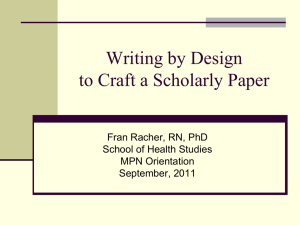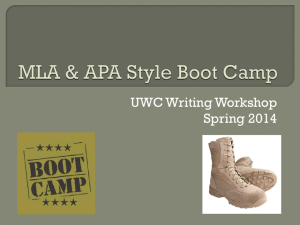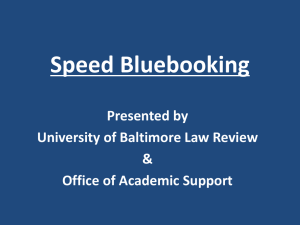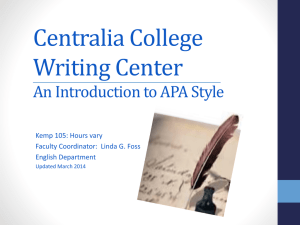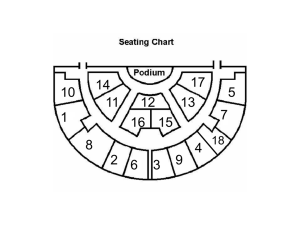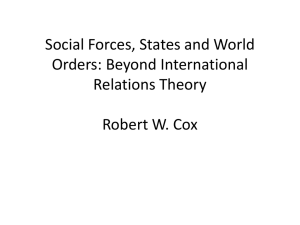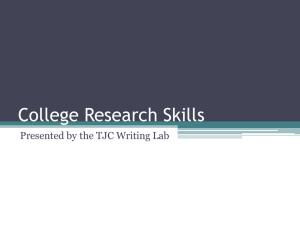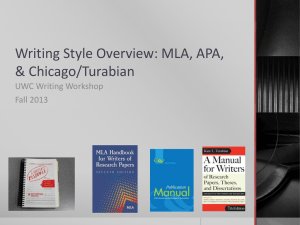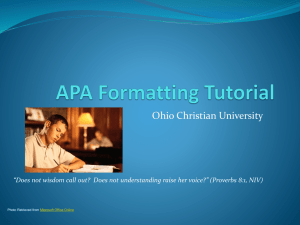Citing & Referencing in APA Style
advertisement
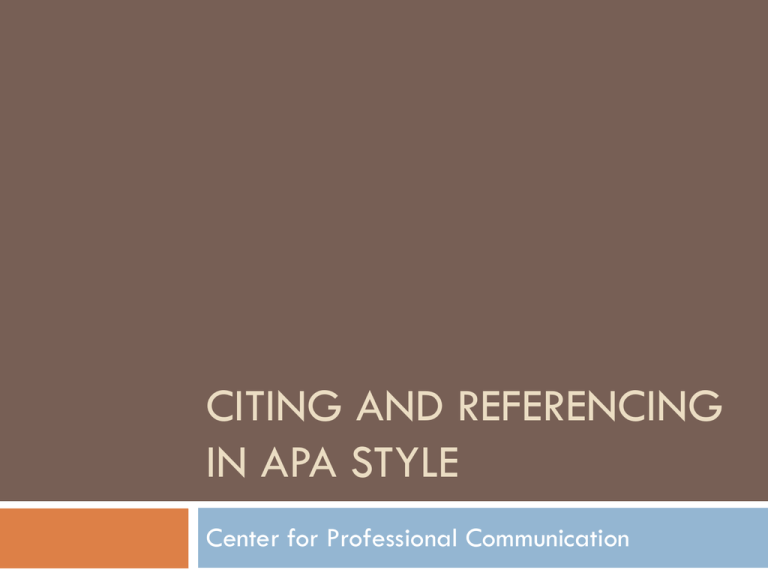
CITING AND REFERENCING IN APA STYLE Center for Professional Communication Academic Misconduct All forms of academic misconduct are prohibited by the Student Code of Conduct. Academic misconduct is an A-level offense and is defined by the student code of conduct as Dishonesty or Deception in fulfilling academic requirements. It includes, but is not limited to: • • • • • • • • cheating plagiarism un-permitted collaboration forged attendance (when attendance is required) fabrication (e.g., use of invented information or falsification of research or other findings) using advantages not approved by the instructor (e.g., unauthorized review of a copy of an exam ahead of time) knowingly permitting another student to plagiarize or cheat from one's work submitting the same assignment in different courses without consent of the instructor. Note: An instructor may impose a grade penalty for academic misconduct and/or file a judicial referral. If you are unsure about a question of academic misconduct, consult your instructor or the director of Judiciaries. If you are found to be involved in academic misconduct, your instructor has the option of lowering your grade or giving you an F grade on the project or in the course, and/or referring you to Judiciaries. Possible sanctions through Judiciaries are suspension, expulsion, or any sanction not less than a reprimand. (University Judiciaries, 2011) What is Plagiarism Merriam-Webster Online Dictionary: to “plagiarize To steal and pass off (the ideas and words of another) as one’s own To use (another’s production) without crediting the source To commit literary theft To present as new and original an idea or product derived from an existing source Plagiarism Turning in someone else’s work as your own Copying words or ideas from someone else without giving credit Failing to put a quotation in quotation marks Giving incorrect information about the source of a quotation Plagiarism Changing words but copying the sentence structure of a source without giving credit Copying so many words or ideas from a source that is makes up the majority of your work, whether you give credit or not Using your own work from previous classes (without faculty consent or citing yourself) Crediting Sources “A critical part of the writing process is helping readers place your contributions in context by citing the researchers who influenced you” (APA, 2010, p. 169). When to Cite Work that directly influenced your work Credit ideas of others you build off of All facts and figures that are not common knowledge Direct quotations and paraphrased material Basic Citation Styles Parenthetical format, subsequent citations in text Type of citation First citation in text Subsequent citations in text Parenthetical format, first citation in text One work by one author Walker (2007) Walker (2007) (Walker, 2007) (Walker, 2007) One work by two authors Walker and Allen (2004) Walker and Allen (2004) (Walker & Allen, 2004) (Walker & Allen, 2004) One work by three authors Bradley, Ramirez, and Soo (1999) Bradley et al. (1999) (Bradley, Ramirez, & Soo, 1999) (Bradley et al., 1999) One work by four authors Bradley, Ramirez, Soo, and Walsh (2006) Bradley et al. (2006) (Bradley, Ramirez, Soo, & Walsh, 2006) (Bradley et al., 2006) Basic Citation Styles Parenthetical format, subsequent citations in text Type of citation First citation in text Subsequent citations in text Parenthetical format, first citation in text One work by five authors Walker, Allen, Bradley, Ramirez, and Soo (2008) Walker et al. (2008) (Walker, Allen, Bradley, Ramirez, & Soo, 2008) (Bradley et al., 2008) One work by six authors Wasserstein et al. (2005) Wasserstein et al. (2005) (Wasserstein et al. 2005) (Wasserstein et al. 2005) Groups ( readily identified through abbreviation) as authors National Institute of Mental Health (NIMH, 2003) NIMH (2003) (National Institute of Mental Health [NIMH], 2003) (NIMH, 2003) Groups (no abbreviation) as authors University of Pittsburgh (2005) University of Pittsburgh (2005) (University of Pittsburgh, 2005) (University of Pittsburgh, 2005) Samples of APA Citations Author mentioned in your text (in-text citation) author year Wilson (1994) has described in detail his fascination with insects. Author cited in parentheses (parenthetical citation) The army retreated from Boston is disarray, making the rebels realize that they had achieved a great victory (McCullough, 2001). author comma year Samples of APA Citations Author quoted quotation Memories are “built around a small collection of dominating images” (Wilson, 1994, p. 5). quotation author comma year comma page number Direct Quotation In Text Interpreting these results, Robbins et al., (2003) suggests that the “therapists in dropout cases may have inadvertently validated parental negativity about the adolescent without adequately responding to the adolescent’s needs or concerns” (p. 541), contributing to an overall climate of negativity. Direct Quotation Parenthetical Confusing this issue is the overlapping nature of roles in palliative care, whereby “medial needs are met by those in the medical disciplines; nonmedical needs may be addressed by anyone of the team” (Csikai & Chaitin, 2006, p. 112). Direction Quotation – Lengthy This is the paragraph leading to the direct quote that is over 40 words. Others have contradicted this view: Co-presence does not ensure intimate interaction among all group members. Consider large-scale social gatherings in which hundreds or thousands of people gather in a location to perform a ritual or celebrate an event. In these instances, participants are able to see the visible manifestation of the group, the physical gathering, yet their ability to make direct, intimate connections with those around this is limited by the sheer magnitude of the assembly. (Purcell, 1997, pp. 111-112) The paper continues as normal after the large direct quote. Samples of APA Citations A work with more than one author author year Kanazawa and Still (2000) in their analysis of a large set of data showed that the statistical likelihood of being divorced increased if one was male and a secondary school teacher or college professor. Analysis of a large set of data showed that the statistical likelihood of being divorced increased if one was male and a secondary school teacher or college professor (Kanazawa & Still, 2000). ampersand first author second author comma year Samples of APA Citations Author’s work cited in another source The words we use simple appear, as Britton says, “at the point of utterance” (as cited in Smith, 1982, p. 108). page number indication that you are referring to a citation in the work author of source you used comma year Work Cited in Another Source “In the United States, the American Cancer Society (2007) estimated that about 1 million cases of NMSC and 59,940 cases of melanoma would be diagnosed in 2007, with melanoma resulting in 8,110 deaths” (Miller et al., 2009, p. 209). Samples of APA Citations More than one work in one citation Criticisms of large-scale educational testing abound (Crouse & Trusheim, 1988; Nairn, 1978, 1980; Sacks, 2003). Author(s) separate sources with a semi-colon comma year Samples of APA Citations Corporation, government agency, or organization as author A survey by the College Entrance Examination Board (CEEB) showed that 43% of total enrollment in higher education was in two-year public institutions. Full-time enrollment was different, with only 24% enrolled in two-year public schools (CEEB, 2002). Abbreviated author comma year Samples of APA Citations No author names Use the complete title if it is short, with capital letters for major words. Within parentheses, you can shorten the title. Reference List The reference list at the end of a work provides the information necessary to identify and retrieve each source. Include only the sources that you used in the research and preparation of the work. References What to list (only those items cited in paper) Format (alphabetical by author’s last name, hanging indenture, double spaced) Conventions of the list Date Periods Capitals Italics Page numbers **Refer to example references posted in forum**


